Longitudinal Displacement Behavior and Girder End Reliability of a Jointless Steel-Truss Arch Railway Bridge during Operation
Abstract
:1. Introduction
2. Bridge Description and Longitudinal Displacement Monitoring
3. Behavior Analysis of the Bridge Longitudinal Displacements
3.1. Time–Frequency Characteristics of the Longitudinal Displacements of the Bridge
3.2. Long-Term Characteristics of the Longitudinal Displacements of the Bridge
4. Girder End Reliability under the Relative Transverse Displacements
4.1. Transverse Behavior of the Girder End Calculated by the Longitudinal Displacement Data
4.2. Mechanical Characteristics of the Expansion Device under Relative Transverse Displacements
4.3. Reliability and Early Warning of the Girder End of the Train-Bridge System
5. Conclusions
Author Contributions
Funding
Conflicts of Interest
References
- Zhao, H.W.; Ding, Y.L.; Geng, F.F.; Li, A.Q. RAMS evaluation for a steel-truss arch high-speed railway bridge based on SHM system. Struct. Monit. Maintenance 2018, 5, 79–92. [Google Scholar]
- Treyssède, F. Finite element modeling of temperature load effects on the vibration of local modes in multi-cable structures. J. Sound Vib. 2018, 413, 191–204. [Google Scholar] [CrossRef]
- Liu, Y.; Qian, Z.; Hu, J.; Jin, L. Temperature Behavior and Stability Analysis of Orthotropic Steel Bridge Deck during Gussasphalt Pavement Paving. J. Bridge Eng. 2018, 23, 04017117. [Google Scholar] [CrossRef]
- Cao, Y.; Yim, J.; Zhao, Y.; Wang, M. Temperature effects on cable stayed bridge using health monitoring system: A case study. Struct. Health Monit. 2010, 10, 523–537. [Google Scholar]
- Van Le, H.; Nishio, M. Time-series analysis of GPS monitoring data from a long-span bridge considering the global deformation due to air temperature changes. J. Civ. Struct. Health Monit. 2015, 5, 415–425. [Google Scholar] [CrossRef]
- Sun, Z.; Zou, Z.; Zhang, Y. Utilization of structural health monitoring in long-span bridges: Case studies. Struct. Control Health Monit. 2017, 24, e1979. [Google Scholar] [CrossRef]
- Xia, Q.; Zhang, J.; Tian, Y.; Zhang, Y. Experimental Study of Thermal Effects on a Long-Span Suspension Bridge. J. Bridge Eng. 2017, 22, 04017034. [Google Scholar] [CrossRef]
- Maguire, M.; Roberts-Wollmann, C.; Cousins, T. Live-Load Testing and Long-Term Monitoring of the Varina-Enon Bridge: Investigating Thermal Distress. J. Bridge Eng. 2018, 23, 04018003. [Google Scholar] [CrossRef]
- Erazo, K.; Sen, D.; Nagarajaiah, S.; Sun, L. Vibration-based structural health monitoring under changing environmental conditions using Kalman filtering. Mech. Syst. Sig. Process. 2019, 117, 1–15. [Google Scholar] [CrossRef]
- Liu, Y.; Zhang, H.; Liu, Y.; Deng, Y.; Jiang, N.; Lu, N. Fatigue reliability assessment for orthotropic steel deck details under traffic flow and temperature loading. Eng. Fail. Anal. 2017, 71, 179–194. [Google Scholar] [CrossRef]
- Liu, Y.; Zhang, S. Probabilistic Baseline of Finite Element Model of Bridges under Environmental Temperature Changes. Comput.-Aided Civ. Infrastruct. Eng. 2017, 32, 581–598. [Google Scholar] [CrossRef]
- Zhao, H.W.; Ding, Y.L.; Nagarajaiah, S.; Li, A.Q. Behavior Analysis and Early Warning of Girder Deflections of a Steel-Truss Arch Railway Bridge under the Effects of Temperature and Trains: Case Study. J. Bridge Eng. 2019, 24, 05018013. [Google Scholar] [CrossRef]
- Guo, T.; Liu, J.; Huang, L. Investigation and control of large cumulative girder movements of long-span steel suspension bridges. Eng. Struct. 2016, 125, 217–226. [Google Scholar] [CrossRef]
- Liu, Z.; Phares, B.M.; Greimann, L.F. Use of Longitudinal Expansion Joints in Wide-Bridge Applications to Reduce Deck Cracking. J. Bridge Eng. 2016, 21, 04016068. [Google Scholar] [CrossRef]
- Sekiya, H.; Maruyama, O.; Miki, C. Visualization system for bridge deformations under live load based on multipoint simultaneous measurements of displacement and rotational response using MEMS sensors. Eng. Struct. 2017, 146, 43–53. [Google Scholar] [CrossRef]
- Luo, L.; Feng, M.Q.; Wu, Z.Y. Robust vision sensor for multi-point displacement monitoring of bridges in the field. Eng. Struct. 2018, 163, 255–266. [Google Scholar] [CrossRef]
- Nagarajaiah, S. Adaptive passive, semiactive, smart tuned mass dampers: identification and control using empirical mode decomposition, hilbert transform, and short-term fourier transform. Struct. Control Health Monit. 2009, 16, 800–841. [Google Scholar] [CrossRef]
- Liu, W.; Cao, S.; Chen, Y. Seismic Time–frequency Analysis via Empirical Wavelet Transform. IEEE Geosci. Remote Sens. Lett. 2016, 13, 28–32. [Google Scholar] [CrossRef]
- Nagarajaiah, S.; Erazo, K. Structural monitoring and identification of civil infrastructure in the United States. Struct. Monit. Maintenance 2016, 3, 51–69. [Google Scholar] [CrossRef]
- Wang, D.; Zhao, Y.; Yi, C.; Tsui, K.L.; Lin, J. Sparsity guided empirical wavelet transform for fault diagnosis of rolling element bearings. Mech. Syst. Sig. Process. 2018, 101, 292–308. [Google Scholar] [CrossRef]
- Wang, G.X.; Ding, Y.L.; Song, Y.S.; Wu, L.Y.; Yue, Q.; Mao, G.H. Detection and Location of the Degraded Bearings Based on Monitoring the Longitudinal Expansion Performance of the Main Girder of the Dashengguan Yangtze Bridge. J. Perform. Constr. Facil. 2016, 30, 04015074. [Google Scholar] [CrossRef]
- Zhao, H.W.; Ding, Y.L.; An, Y.H.; Li, A.Q. Transverse Dynamic Mechanical Behavior of Hangers in the Rigid Tied-Arch Bridge under Train Loads. J. Perform. Constr. Facil. 2017, 31, 04016072. [Google Scholar] [CrossRef]
- Ding, Y.L.; Zhao, H.W.; Deng, L.; Li, A.Q.; Wang, M.Y. Early Warning of Abnormal Train-Induced Vibrations for a Steel-Truss Arch Railway Bridge: Case Study. J. Bridge Eng. 2017, 22, 05017011. [Google Scholar] [CrossRef] [Green Version]
- Gilles, J. Empirical wavelet transform. IEEE Trans. Signal Process. 2013, 61, 3999–4010. [Google Scholar] [CrossRef]
- Huang, N.E.; Shen, Z.; Long, S.R.; Wu, M.C.; Shih, H.H.; Zheng, Q.; Yen, N.-C.; Tung, C.C.; Liu, H.H. The empirical mode decomposition and the Hilbert spectrum for nonlinear and non-stationary time series analysis. In Proceedings of the Royal Society of London. Series A: Mathematical, Physical and Engineering Sciences, London, UK, 8 March 1998; Royal Society: London, UK; pp. 903–995. [Google Scholar]
- Ministry of Railways of the People’s Republic of China. TB/T 2331-2013: Pot Bearing for Railway Bridge; China Railway Publishing House: Beijing, China, 2014. (In Chinese) [Google Scholar]
- Li, Y.L.; Xiang, H.Y.; Wan, T.B.; Ren, H.Q. Performance of Train Running over Expansion Joints at Beam Ends of Long-span Railway Bridge. J. Chin. Railway Soc. 2012, 34, 94–99. (In Chinese) [Google Scholar]
- Railway Engineering Research Institute of CARS. Temporary Technical Regulations for the Expansion Devices in the Girder End of the Dashengguan Yangtze River Bridge and Jinan Yellow River Bridge on the Beijing–Shanghai High-Speed Railway; Chinese Academy of Railway Sciences: Beijing, China, 2010. (In Chinese) [Google Scholar]
- National Railway Administration of the People’s Republic of China. TB 10621-2014: Code for Design of High Speed Railway; China Railway Publishing House: Beijing, China, 2016. (In Chinese)
- National Railway Administration of the People’s Republic of China. TB 10082-2017: Code for Design of Railway Track; China Railway Publishing House: Beijing, China, 2018. (In Chinese)
- Botev, Z.I.; Grotowski, J.F.; Kroese, D.P. Kernel Density Estimation via Diffusion. Ann. Stat. 2010, 38, 2916–2957. [Google Scholar] [CrossRef]
- Balomenos, G.P.; Padgett, J.E. Fragility Analysis of Pile-Supported Wharves and Piers Exposed to Storm Surge and Waves. J. Waterw. Port Coastal Ocean Eng. 2018, 144, 04017046. [Google Scholar] [CrossRef]
- Memmolo, V.; Pasquino, N.; Ricci, F. Experimental characterization of a damage detection and localization system for composite structures. Measurement 2018, 129, 381–388. [Google Scholar] [CrossRef]
- CEN. EN1993-1-9: Eurocode 3: Design of Steel Structures: Part 1–9: Fatigue; European Committee for Standardization: Brussels, Belgium, 2005. [Google Scholar]
- AASHTO. Guide Specifications for Fatigue Evaluation of Existing Steel Bridges; American Association of State Highway and Transportation Officials: Washington, DC, USA, 1990. [Google Scholar]


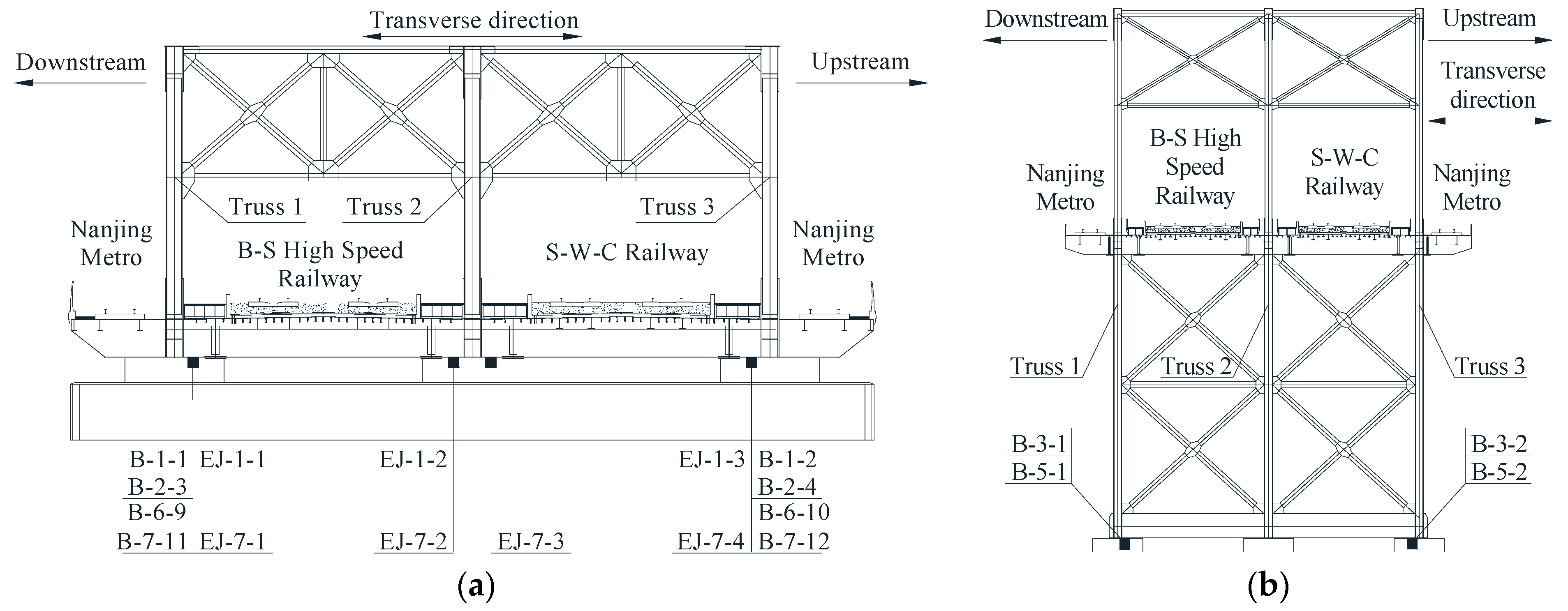
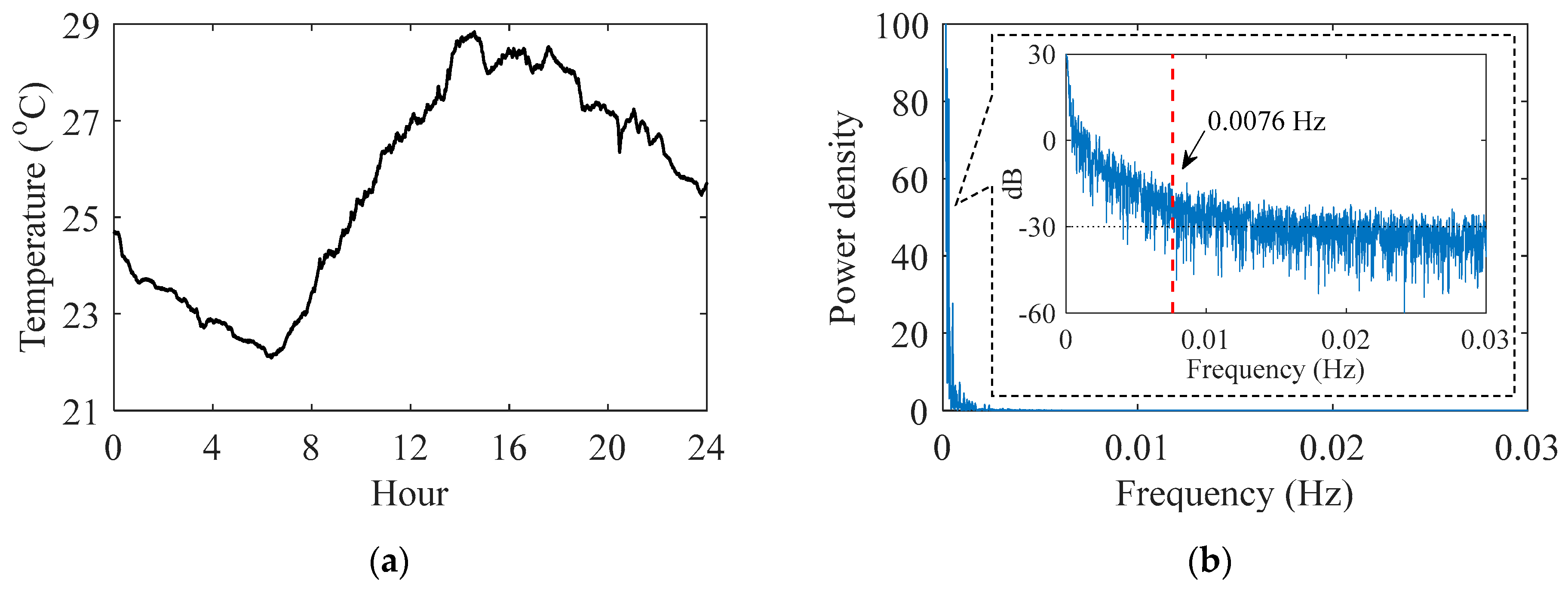
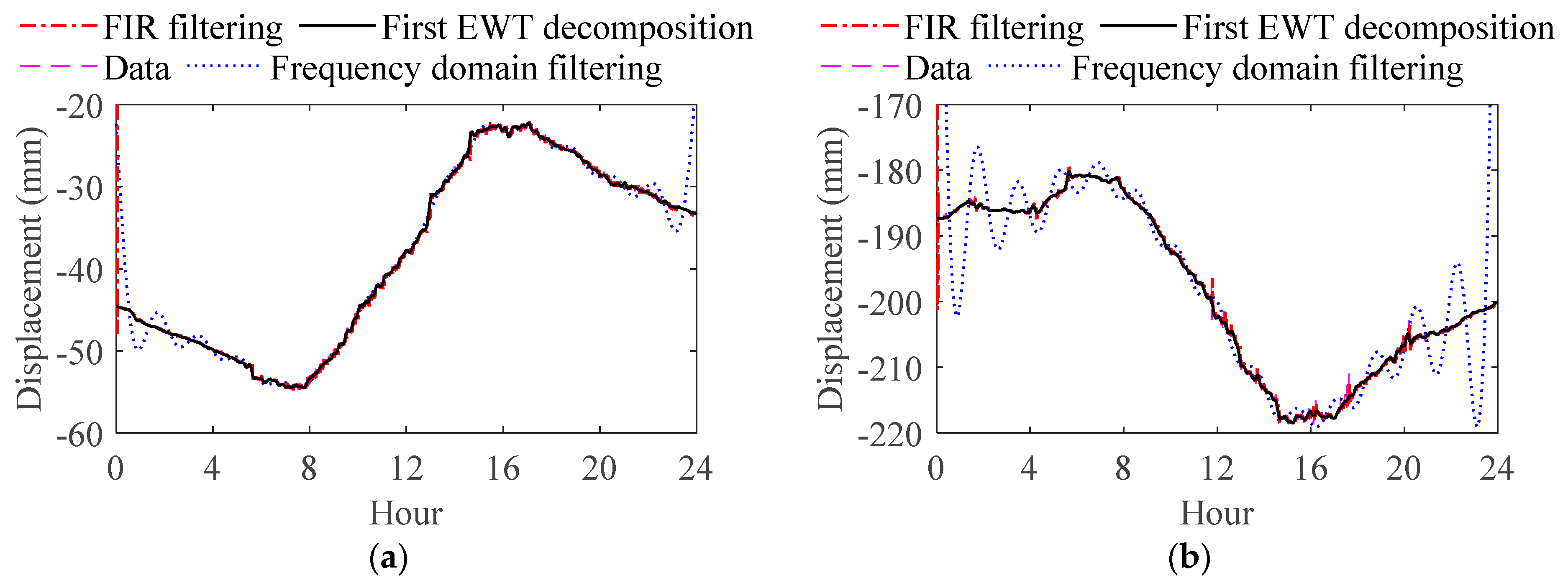
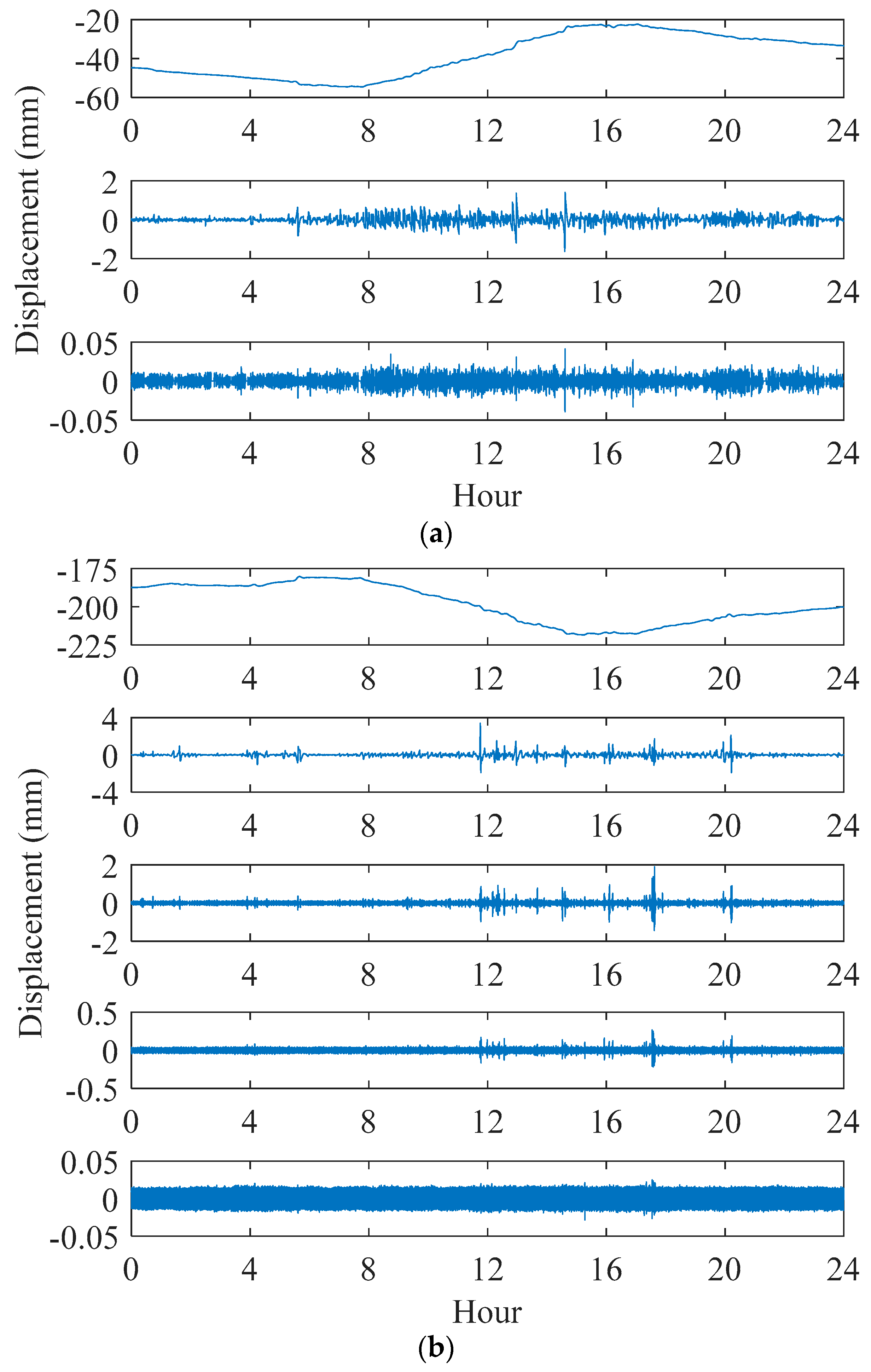
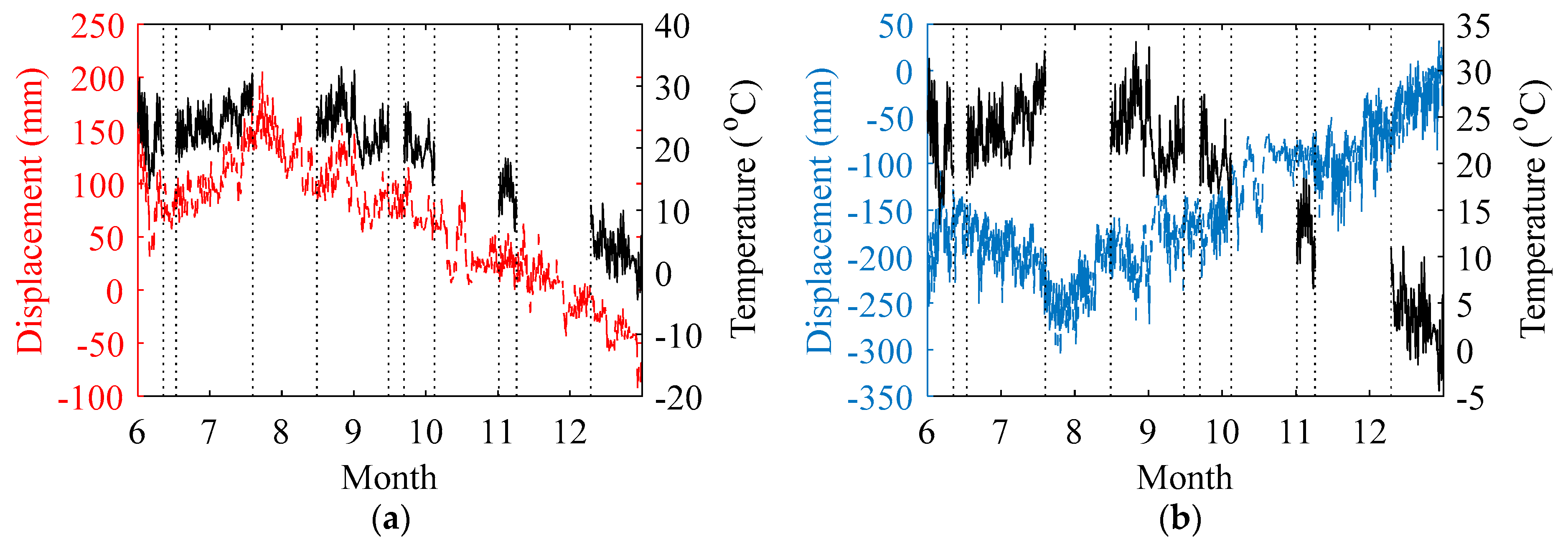


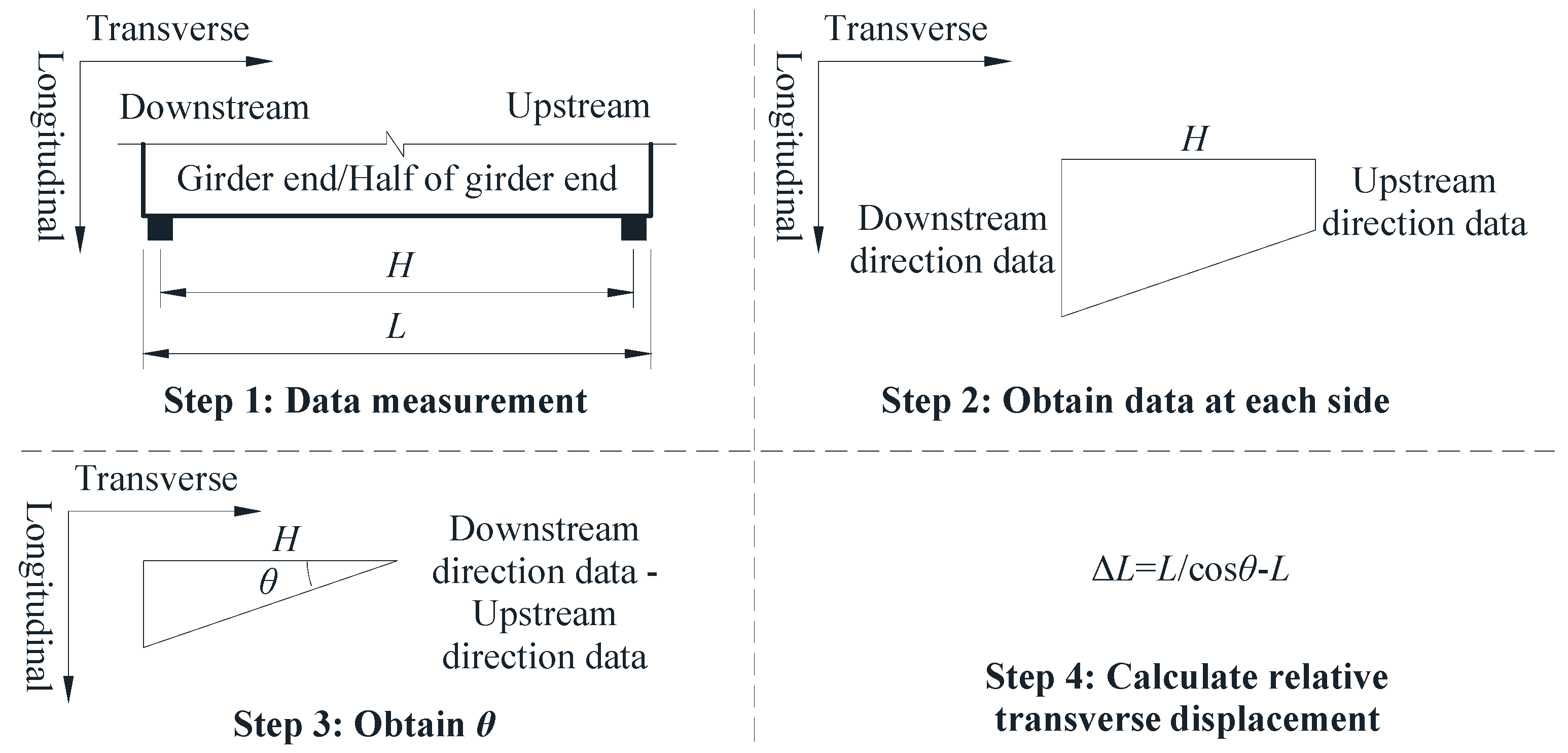
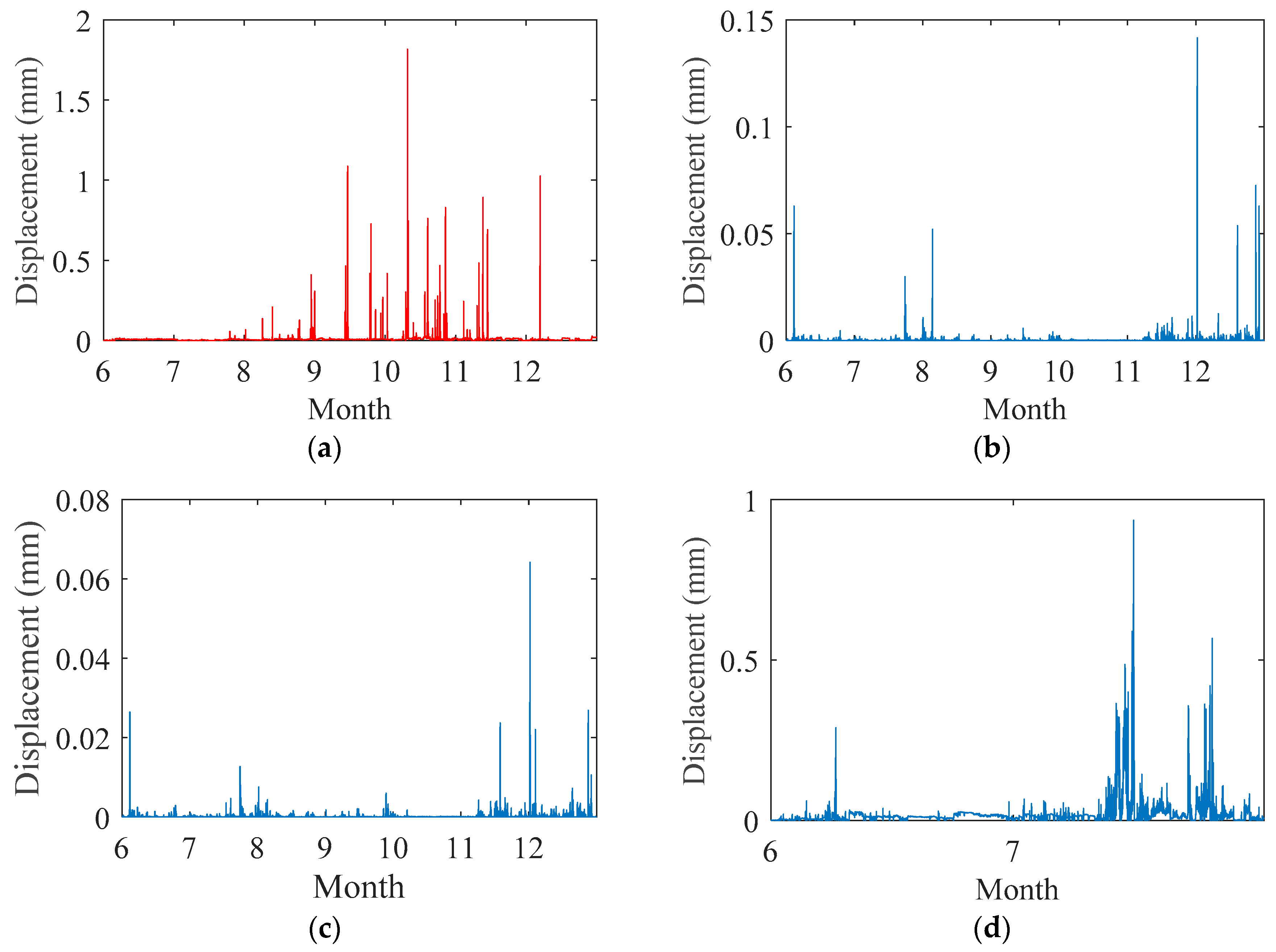
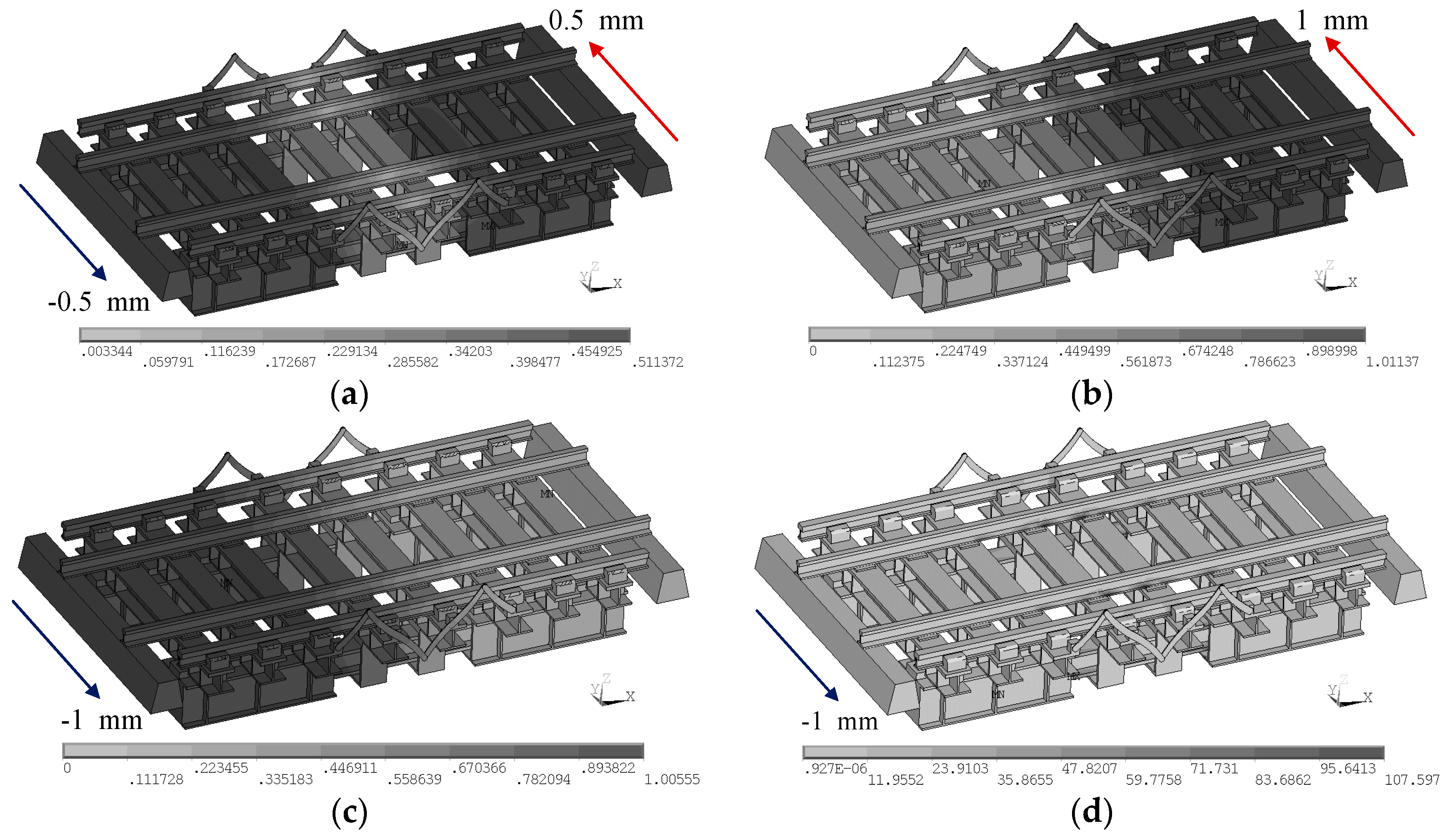


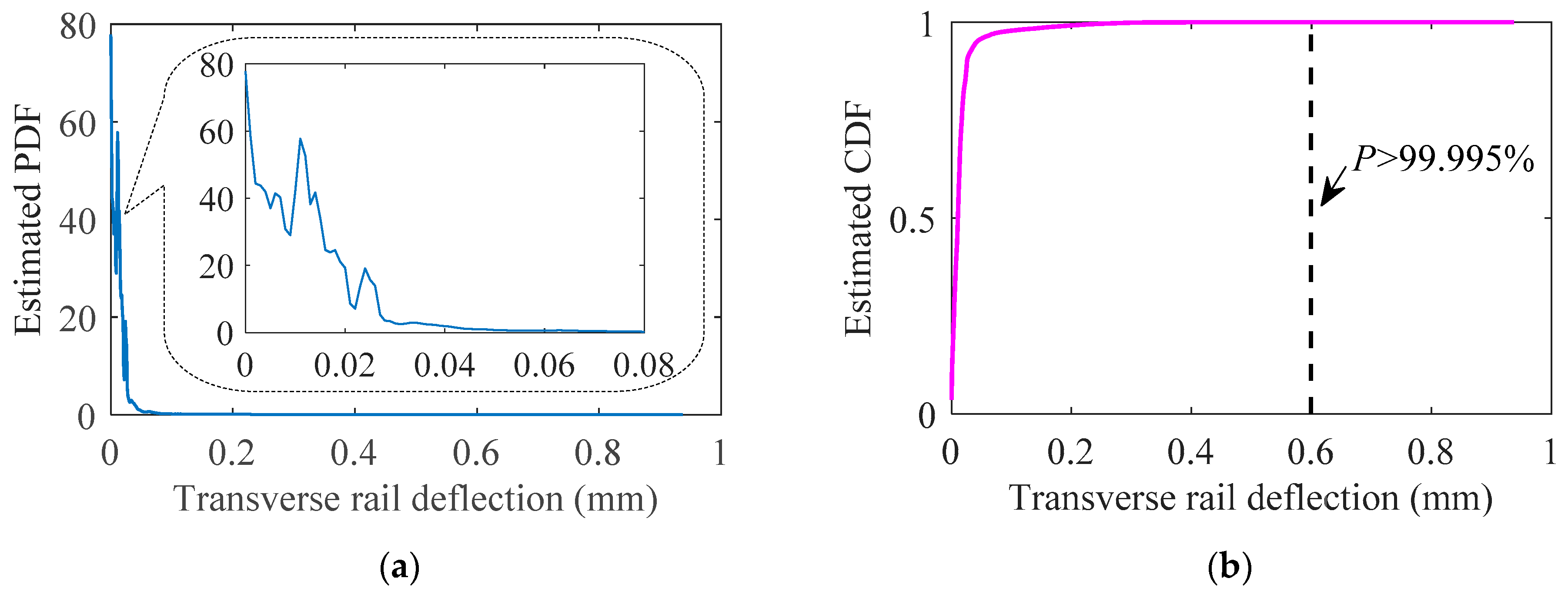
| Location of Bearings | Pier 1 | Pier 2 | Pier 3 | Pier 5 | Pier 6 | Pier 7 |
|---|---|---|---|---|---|---|
| Cumulation Displacement in One Year (unit: km) | 0.6165 | 1.0910 | 1.1018 | 1.0489 | 0.9456 | 0.6154 |
| Wear Rate in One Year (Compared with 50 km) | 0.0123 | 0.0218 | 0.0220 | 0.0210 | 0.0189 | 0.0123 |
| Wear Time Every 50 km (unit: Years) | 81.10 | 45.83 | 45.38 | 47.67 | 52.88 | 81.24 |
| Mechanical Responses | Maximum Value | Maximum Value Location |
|---|---|---|
| Transverse deflection of rails | −1.00069 mm | Rails fastened on the steel sleepers at the fixed side. |
| von Mises stress of sliding supports | 107.60 MPa | Contact areas of the sliding support and the fixed box mouth. |
| von Mises stress of guide rails | 48.05 MPa | Contact areas of the guide rails and the hanging steel sleeper (including the fasteners). |
| von Mises stress of rails | 88.44 MPa | Contact areas of the rails and the hanging steel sleeper (including the fasteners). |
| von Mises stress of scissor-like connecting rods | 42.72 MPa | Middle rotating shafts of the scissor-like connecting rods connected with the steel sleeper. |
© 2019 by the authors. Licensee MDPI, Basel, Switzerland. This article is an open access article distributed under the terms and conditions of the Creative Commons Attribution (CC BY) license (http://creativecommons.org/licenses/by/4.0/).
Share and Cite
Zhao, H.; Ding, Y.; Nagarajaiah, S.; Li, A. Longitudinal Displacement Behavior and Girder End Reliability of a Jointless Steel-Truss Arch Railway Bridge during Operation. Appl. Sci. 2019, 9, 2222. https://doi.org/10.3390/app9112222
Zhao H, Ding Y, Nagarajaiah S, Li A. Longitudinal Displacement Behavior and Girder End Reliability of a Jointless Steel-Truss Arch Railway Bridge during Operation. Applied Sciences. 2019; 9(11):2222. https://doi.org/10.3390/app9112222
Chicago/Turabian StyleZhao, Hanwei, Youliang Ding, Satish Nagarajaiah, and Aiqun Li. 2019. "Longitudinal Displacement Behavior and Girder End Reliability of a Jointless Steel-Truss Arch Railway Bridge during Operation" Applied Sciences 9, no. 11: 2222. https://doi.org/10.3390/app9112222




